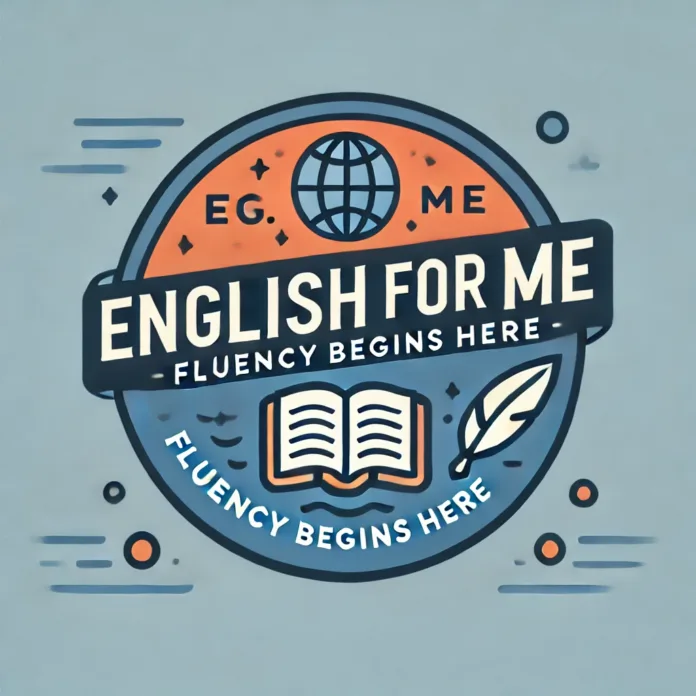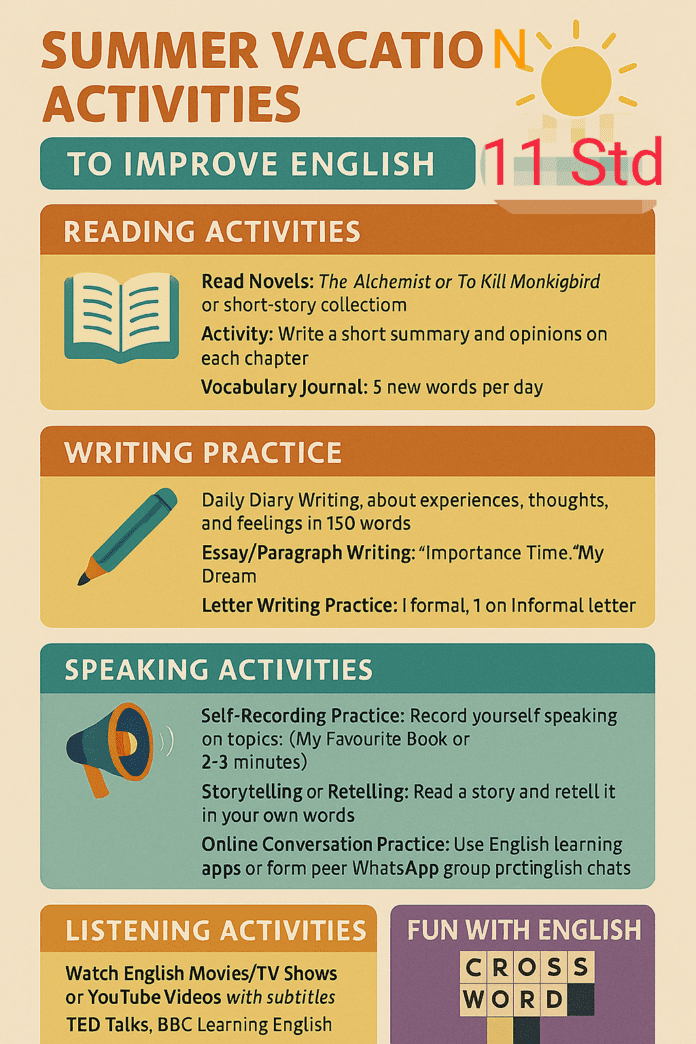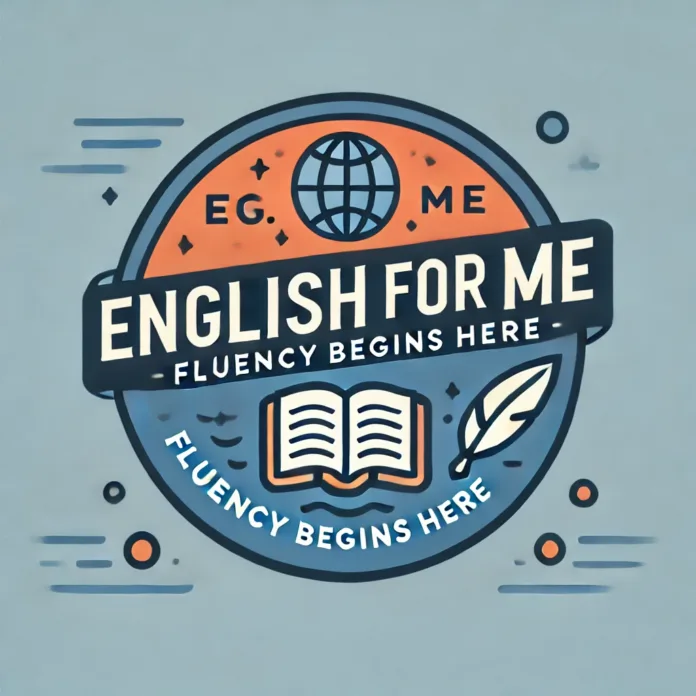Here’s a 4-week beginner-level English writing plan, with one short writing task each day. It’s designed to build confidence gradually.
सूचना:
या प्लॅन चा उपयोग 5 वी ते 12 वी इयत्तेतील विद्यार्थ्यांपासून इंग्रजी शिकू इच्छिणाऱ्या प्रौढांपर्यंत कुणीही करू शकतो. शिक्षक, पालक किंवा विद्यार्थी – जो कोणी सराव करेल त्याला याचा नक्कीच फायदा होईल.
Week 1: Personal and Daily Life Writing
Day 1: Introduce yourself
Day 2: Write about your daily routine
Day 3: Describe your family
Day 4: Write about your favourite food
Day 5: Describe your best friend
Day 6: Write a short story (5–6 sentences)
Day 7: Write about your future dream (job, travel, etc.)
Begin like this.
Day 1: Introduce Yourself
Task: Write a short paragraph about yourself.
Example Questions:
What is your name?
Where are you from?
What do you do?
What are your hobbies?
Example:
My name is Riya. I am from Nagpur. I am a student. I like reading books and listening to music.
Day 2: Write About Your Daily Routine
Task: Describe your day from morning to evening.
Use time words like: in the morning, after lunch, at night, etc.
Example:
I wake up at 6 a.m. I brush my teeth and take a bath. I go to college at 9 a.m. I study and come back home in the evening.
Day 3: Write About Your Family
Task: Describe your family members.
Mention: names, age, jobs, likes/dislikes.
Example:
I live with my parents and one sister. My father is a teacher. My mother is a housewife. My sister is in class 10.
Day 4: Write About Your Favourite Thing
Task: Write about your favourite food/book/film/place.
Use simple adjectives like: good, tasty, interesting, beautiful, etc.
Example:
My favourite food is biryani. It is very tasty. My mother cooks it on Sundays. I enjoy eating it with my family.
Day 5: Write a Short Story (5–6 sentences)
Task: Create a very short and simple story using past tense.
Example:
Yesterday, I went to the market. I saw a puppy near the shop. It was hungry. I gave it a biscuit. The puppy was happy. I felt good.
Day 6: Write a Message or Note
Task: Write a message to your friend or a note to your teacher.
Example:
Message to a Friend:
Hi Ramesh, I am not feeling well today. I will not come to school. Please tell the teacher. — Suresh
Day 7: Write About Your Future Plans
Task: Write what you want to become or do in the future.
Example:
I want to become a doctor. I want to help sick people. I will study hard and make my dream come true.
Week 2: Everyday Topics
Day 8: Describe your school/college
Day 9: Write about your favourite teacher
Day 10: Write about your hobby
Day 11: Describe your village/town/city
Day 12: Write about a festival you celebrate
Day 13: Write a message to a friend
Day 14: Write about what you do on Sunday
Week 3: Practice with Past and Future Tenses
Day 15: Write about what you did yesterday
Day 16: Write about a happy moment in your life
Day 17: Describe your birthday celebration
Day 18: Write a story using past tense (6–8 lines)
Day 19: Write your plan for the weekend
Day 20: Write a letter to your friend inviting them for a visit
Day 21: Write about what you will do during your vacation
Week 4: Simple Creative and Functional Writing
Day 22: Write 5 sentences using “because”
Day 23: Write a paragraph on “My Favourite Season”
Day 24: Write instructions for making tea or any dish
Day 25: Write a short dialogue (4–5 lines) between two friends
Day 26: Write an application for leave
Day 27: Describe a picture (you can choose any from a book or online)
Day 28: Write a short review of a movie or book you like
Here are the Worksheets for Week 2 to Week 4 in the same format:
Worksheet कशी वापरावी?
1. दररोज एक Worksheet पूर्ण करावी:
प्रत्येक दिवसासाठी एक वेगळी activity आहे. ती त्या दिवशी पूर्ण करावी.
एका दिवसात फार मोठं टार्गेट न ठेवता 4–6 वाक्य लिहिण्याचा सराव करावा.
2. तोंडी वाचन करावे:
लिहिलेल्या वाक्यांचे दोन वेळा मोठ्याने वाचन करावे. त्यामुळे उच्चार सुधारतात.
3. शब्दसंग्रह वाढवा:
worksheet मध्ये वापरलेले नवीन शब्द वेगळ्या वहीत लिहा.
त्यांचे अर्थ, वाक्ये आणि प्रतिदिन ५ शब्दांचा सराव करा.
4. शिक्षक किंवा पालकांकडून तपासणी घ्या:
आपल्या लिखाणात चूक झाल्यास शिक्षक/पालक मार्गदर्शन देतील.
योग्य शुद्धलेखन व व्याकरण शिका.
5. स्वतःलाच प्रश्न विचारा:
“मी काय लिहिले?”, “हे अजून चांगल्या प्रकारे कसे लिहू शकतो?”
Worksheet ची उपयुक्तता:
1. लिहिण्याची भीती दूर होते:
सुरुवातीस चुका होतात, पण सरावामुळे आत्मविश्वास वाढतो.
2. विचार व्यक्त करण्याची सवय लागते:
साध्या गोष्टी लिहून सुरुवात करून, हळूहळू आपले विचार इंग्रजीत मांडता येतात.
3. शब्दसंपत्ती (Vocabulary) वाढते:
रोज वेगळ्या विषयावर लिहिल्याने नवे शब्द शिकायला मिळतात.
4. व्याकरणाचे योग्य ज्ञान होते:
वाक्यरचना, काल (Tense), सर्वनाम (Pronouns) यांचा सराव होतो.
5. परीक्षा व संभाषणासाठी उपयोगी:
अभ्यासासोबत प्रत्यक्ष जीवनात इंग्रजी वापरता येते.
Beginner English Writing Practice – Week 2 Worksheet
Day 8: My School / College
Write 4–5 sentences about your school/college – its name, location, teachers, and what you like.
Day 9: My Favourite Teacher
Write about the teacher you like the most – name, subject, teaching style.
Day 10: My Hobby
What is your favourite hobby? Why do you like it? When do you do it?
Day 11: My Town / Village / City
Describe where you live – name, places, people, what you like about it.
Day 12: My Favourite Festival
Write 5–6 lines about your favourite festival and how you celebrate it
Day 13: Message to a Friend
Write a short message to your friend. (e.g., you are absent, invite them, thank them, etc.)
Day 14: My Sunday
How do you spend your Sunday? Write 4–5 sentences.
Beginner English Writing Practice – Week 3 Worksheet
Day 15: What I Did Yesterday
Describe your activities yesterday in the past tense (5–6 lines).
Day 16: A Happy Moment
Write about a happy day or event in your life.
Day 17: My Birthday
How do you celebrate your birthday? Who comes, what do you do?
Day 18: Story Using Past Tense
Write a short story (6–8 lines) using “went, saw, ate, gave, was, had” etc.
Day 19: My Weekend Plan
Write about what you will do this Saturday and Sunday.
Day 20: Letter to a Friend (Invitation)
Write a letter inviting your friend to your house or function.
Day 21: My Vacation Plan
Where do you want to go? What will you do? Write 4–5 lines.
Beginner English Writing Practice – Week 4 Worksheet
Day 22: Sentences Using “Because”
Write 5 sentences using “because”.
Example: I stayed home because it was raining.
Day 23: My Favourite Season
Write 5–6 lines about your favourite season (summer, winter, rainy, etc.).
Day 24: How to Make Tea (or another dish)
Write 5–6 steps or instructions.
Day 25: A Short Dialogue Between Friends
Write 4–5 lines of conversation.
Example:
A: Hi, how are you?
B: I’m good. What about you?
________________________________________________________________________________________________________________________________
Day 26: Leave Application
Write an application to your teacher for 2 days’ leave.
________________________________
Day 27: Describe a Picture
Choose any picture and describe what you see (5–6 lines). (You can use a textbook image or cut/paste one.)
________________________________
Day 28: Book or Movie Review
Write 4–5 lines about a movie or book you like. What is it about? Why do you like it?










